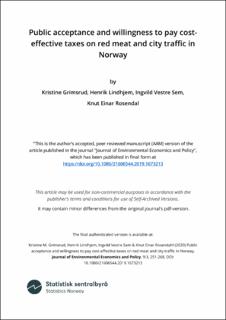| dc.contributor.author | Grimsrud, Kristine | |
| dc.contributor.author | Lindhjem, Henrik | |
| dc.contributor.author | Sem, Ingvild Vestre | |
| dc.contributor.author | Rosendahl, Knut Einar | |
| dc.date.accessioned | 2021-06-08T15:06:44Z | |
| dc.date.available | 2021-06-08T15:06:44Z | |
| dc.date.created | 2019-11-22T18:03:50Z | |
| dc.date.issued | 2019 | |
| dc.identifier.citation | Journal of Environmental Economics and Policy. 2019, 9 251-268. | en_US |
| dc.identifier.issn | 2160-6544 | |
| dc.identifier.uri | https://hdl.handle.net/11250/2758552 | |
| dc.description.abstract | The Norwegian Green Tax Commission proposes inter alia cost-effective taxes on red meat and city traffic to reduce greenhouse gas emissions and local air pollution. Implementation requires public support, but the acceptance of and willingness to pay (WTP) such taxes are not known. We conducted a national survey of the public's acceptance of and WTP the two taxes. The survey instrument showed the reduction in emissions/pollution dynamically for each tax level chosen. Despite survey information about the purpose of the taxes, only 25%, on average, were in favour of their introduction, the rest did not know, had zero WTP, or opposed the taxes. In this respect, preferences for the two taxes are similar. However, on average people are WTP approximately 90% of the cost-effective tax level for red meat, but only about 25%-35% of the tax on city traffic, depending on fuel type. The most important concern in designing environmental policy was to avoid increased economic inequality. Earmarking the tax revenue for environmentally friendly technology increased acceptable tax level for red meat. Earmarking tax revenues for reduced income tax did not increase the acceptability of proposed taxes on neither red meat nor city traffic." | en_US |
| dc.language.iso | eng | en_US |
| dc.rights | Navngivelse 4.0 Internasjonal | * |
| dc.rights.uri | http://creativecommons.org/licenses/by/4.0/deed.no | * |
| dc.title | Public acceptance and willingness to pay cost-effective taxes on red meat and city traffic in Norway | en_US |
| dc.type | Peer reviewed | en_US |
| dc.type | Journal article | en_US |
| dc.description.version | acceptedVersion | en_US |
| dc.subject.nsi | VDP::Samfunnsvitenskap: 200::Økonomi: 210 | en_US |
| dc.source.pagenumber | 251-268 | en_US |
| dc.source.volume | 9 | en_US |
| dc.source.journal | Journal of Environmental Economics and Policy | en_US |
| dc.identifier.doi | https://doi.org/10.1080/21606544.2019.1673213 | |
| dc.identifier.cristin | 1751254 | |
| dc.relation.project | Norges forskningsråd: 209698 | en_US |
| cristin.ispublished | true | |
| cristin.fulltext | postprint | |
| cristin.qualitycode | 1 | |

